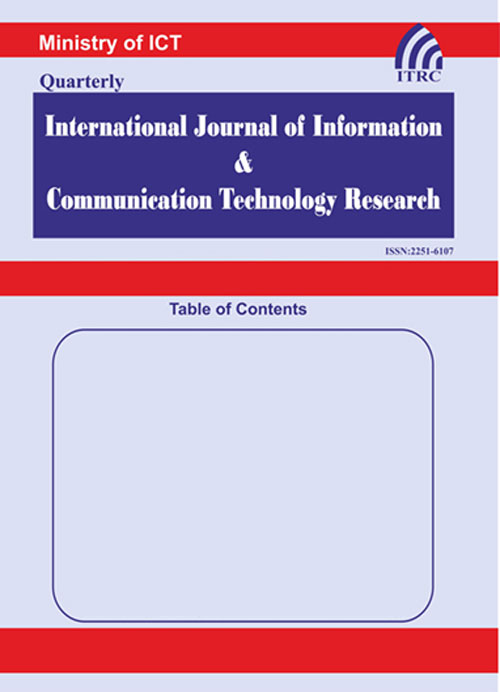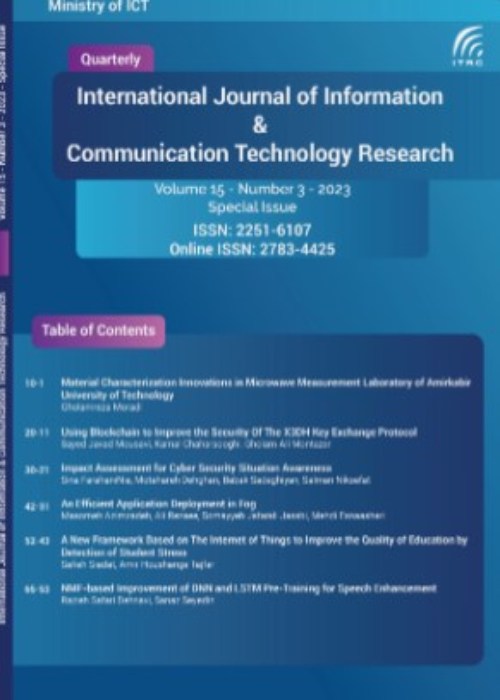فهرست مطالب

International Journal Information and Communication Technology Research
Volume:6 Issue: 4, Autumn 2014
- تاریخ انتشار: 1393/10/11
- تعداد عناوین: 7
-
-
Pages 1-7In this paper, microwave filters were designed using dielectric layers, which were transversely located inside a partial H-plane waveguide. The proposed structure can be used to design microwave filters with arbitrary frequency response including band-pass or band-reject filters. Its longitude was reduced by about 31% compared with conventional partial H-plane band-pass filters. Since the cross-section of partial H-plane waveguide, in a determined frequency range, is one quarter of the conventional waveguide, then the proposed filter has the cross-section of one quarter compared with the counterpart E-plane waveguide filter. Besides compactness, it is easy to fabricate, cheap, mass producible, mechanically stable, and capable of sustaining high microwave power and has very good adjustment to any arbitrary ideal filter. The proposed partial H-plane band-pass filter and its performance in terms of compactness and adjustment to any arbitrary ideal filter were verified by designing and simulating three filters.Keywords: Partial H-plane waveguide, Partial H-plane filter, Band-pass E-plane filter, Compact microwave filter, Band-pass microwave filter
-
Pages 7-12In the past few years, the design of RFID authentication protocols in accordance with the EPC Class-1 Generation-2 (EPC C1 G2) standards, has been one of the most important challenges in the information security domain. Although RFID systems provide user-friendly services for end-users, they can make security and privacy concerns for them. In this paper we analyze the security of an RFID mutual authentication protocol which is based on EPC Class-1 Generation-2 standard and proposed in 2013. The designers of protocol claimed that their protocol is secure against different security attacks and provides user privacy. In this paper, we show that unlike their claims, their protocol is not secure against most of the security attacks such as replay attack, the tag’s ID exposure, and the spoofing attacks. As a result, their protocol cannot provide security of RFID users in different authentication applications. Finally, in order to prevent the aforementioned attacks and overcome all the existing weaknesses, we apply a modification in the updating procedure of the protocol and propose a strengthened version of it.Keywords: Security, Privacy, RFID Authentication protocols, EPC Class-1 Generation-2 standards
-
Pages 13-26Having facilities such as being in text form, having end-to-end connection establishment and being independent from type of transmitted data, SIP protocol is a good choice for signaling protocol in order to set up a connection between two users of an IP network. However, utilization of SIP protocol in a wide range of applications has made various vulnerabilities in this protocol, amongst which overload could make serious problems in SIP servers. An SIP is overloaded when it does not have sufficient resources (majorly CPU processing power and memory) to process all messages. In this paper, attempts were made to improve window-based overload control in RFC 6537. In window-based overload control method, a window is used to limit the number of messages that are sent to an overloaded SIP proxy simultaneously. In this paper, first, fuzzy logic was used to regulate accurate size of window and then it was developed, implemented and evaluated on an Asterisk open-source proxy. Implementation results showed that this method could practically maintain throughput under overload conditions, dynamically change the maximum window size, and also fairly treat among various upstream servers.Keywords: SIP, Overload control, Window based, Asterisk proxy, Fuzzy logic
-
Pages 27-33Enterprise Architecture (EA) is the most suitable approaches intended to assist companies in achieving their long-term objective. Meanwhile, establishing EA in an organization is a costly and time-consuming task. We can analyze the EA scenarios using famous IT governance frameworks to achieve IT and business alignment. In this paper, we propose a new analytical approach for selecting and ranking EA scenarios according to the criteria of a well-established IT governance framework, namely COBIT. We propose a new group-based analytical approach based on a novel DEA model combined with p-robust technique.Keywords: Enterprise Architecture, COBIT, Data Envelopment Analysis, Group Decision Making, P-robustness
-
Pages 41-47Recent advances in technology and the integration of these advances in instructional design have led to a mass individualization where personalized instruction is offered simultaneously to large groups of learners. The first step to adapt instruction is forming different groups of learners based on their attributes. Many methods have used to form learners’ groups in e-learning environment specially data mining techniques such as clustering methods. This paper aims to propose a clustering method to group learners based on their cognitive style and using some specific learners’ observable behaviors while working by system. The objective function of proposed method is defined by considering two criteria in measuring the clustering goodness, compactness and separation, and Particle Swarm Optimization (PSO) method is used to optimize the objective function. This method used to group learners based on cognitive style. Results of the proposed method are compared with K-means, fuzzy C-means, and EFC methods using Davies-Bouldin clustering validity index and comparing the achieved groups based on the cognitive style of learners who are in the same group, shows that the grouping accuracy is in a higher level using fuzzy-inspired PSO method and this method has the better clustering performance than the others and groups similar learners in one cluster.Keywords: e, Learning System, cognitive Style, Grouping, Fuzzy clustering, Particle Swarm Optimization (PSO)
-
Pages 49-57Determining the best way of learning and acquiring knowledge, especially in intelligent tutoring systems have drawn researcher's attention during past years. With regard to studies conducted on E-learning systems and strategies proposed to improve the quality of these systems, it can be said that the interactions play a vital role in the educational systems. Therefore, the learners are not only affected by the teacher in a learning environment but also significantly learn important materials through the interaction with other learners. In this article, a new modeling approach is presented for improving learning/teaching models as well as interaction among learners, from which the most benefit can be derived by learners. The proposed model uses cellular learning automata in order to model behavior of the learners as well as interactions between the learners for knowledge acquisition. This algorithm also deals with the process of teaching as well as education of the learners. The results indicate that relationship between the learners can improve their knowledge and also increase their learning speed compared to previous methods.Keywords: learning automata, cellular learning automata, interactive learning, tutorial-like system
-
Pages 59-69We propose three novel reordering models for statistical machine translation. These reordering models use dependency tree to improve the translation quality. All reordering models are utilized as features in a log linear framework and therefore guide the decoder to make better decisions about reordering. These reordering models are tested on two English-Persian parallel corpora with different statistics and domains. The BLEU score is improved by 2.5 on the first corpus and by 1.2 on the other.Keywords: statistical machine translation, reordering model, dependency tree, discriminative reordering model, discriminative decoder, long range reordering, maximum entropy, distortion model


